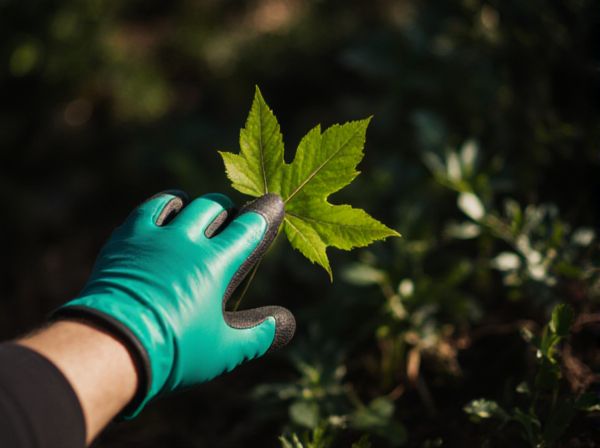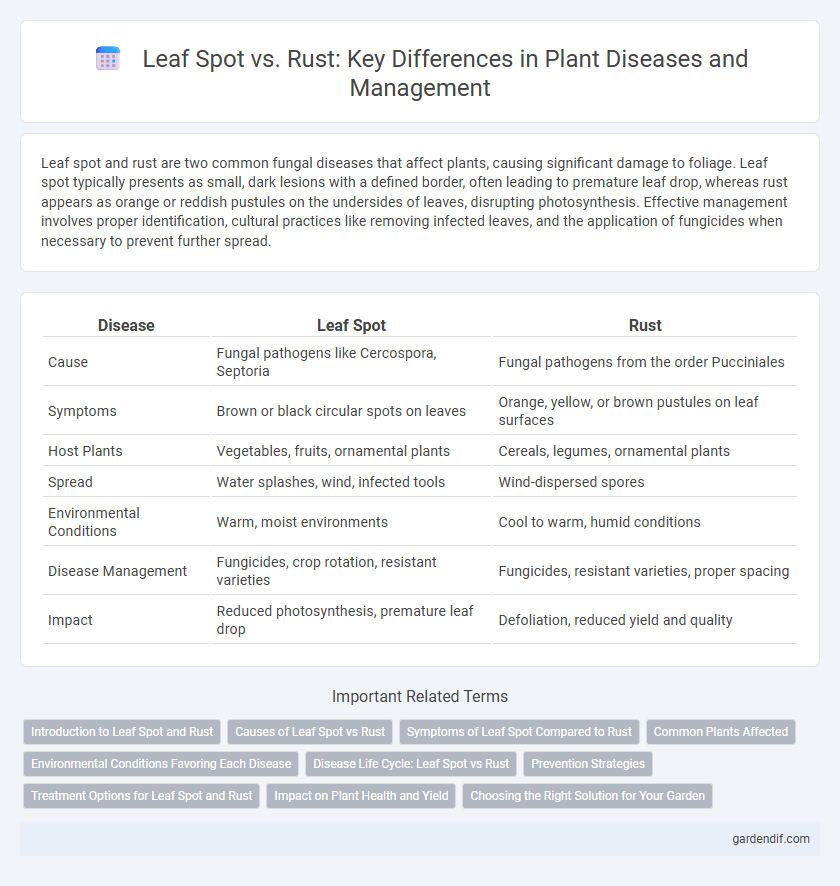
Leaf spot vs Rust Illustration
Leaf spot and rust are two common fungal diseases that affect plants, causing significant damage to foliage. Leaf spot typically presents as small, dark lesions with a defined border, often leading to premature leaf drop, whereas rust appears as orange or reddish pustules on the undersides of leaves, disrupting photosynthesis. Effective management involves proper identification, cultural practices like removing infected leaves, and the application of fungicides when necessary to prevent further spread.
Table of Comparison
| Disease | Leaf Spot | Rust |
|---|---|---|
| Cause | Fungal pathogens like Cercospora, Septoria | Fungal pathogens from the order Pucciniales |
| Symptoms | Brown or black circular spots on leaves | Orange, yellow, or brown pustules on leaf surfaces |
| Host Plants | Vegetables, fruits, ornamental plants | Cereals, legumes, ornamental plants |
| Spread | Water splashes, wind, infected tools | Wind-dispersed spores |
| Environmental Conditions | Warm, moist environments | Cool to warm, humid conditions |
| Disease Management | Fungicides, crop rotation, resistant varieties | Fungicides, resistant varieties, proper spacing |
| Impact | Reduced photosynthesis, premature leaf drop | Defoliation, reduced yield and quality |
Introduction to Leaf Spot and Rust
Leaf spot and rust are common fungal diseases that affect a wide variety of plants, causing significant damage to foliage. Leaf spot manifests as circular or irregular lesions with dark borders, often resulting in premature leaf drop, while rust produces distinctive orange, yellow, or brown pustules on leaf surfaces. Understanding the specific symptoms and fungal pathogens involved is crucial for effective disease management and prevention in agriculture and horticulture.
Causes of Leaf Spot vs Rust
Leaf spot is primarily caused by fungal pathogens such as Alternaria, Cercospora, and Septoria species, which thrive in moist, warm environments promoting localized necrotic lesions on leaves. Rust is caused by obligate parasitic fungi of the order Pucciniales, producing characteristic rust-colored pustules that disrupt photosynthesis and nutrient flow in the host plant. Both diseases are influenced by environmental conditions, but rust fungi require specific alternate hosts to complete their life cycles, unlike most leaf spot pathogens.
Symptoms of Leaf Spot Compared to Rust
Leaf spot presents as small, dark, circular lesions with distinct borders, often accompanied by yellow halos around the spots. Rust produces powdery, orange to reddish pustules primarily on the undersides of leaves, which can eventually cause leaf deformation and premature drop. While leaf spot causes necrotic tissue patches, rust leads to raised, spore-filled spots that impair photosynthesis more rapidly.
Common Plants Affected
Leaf spot commonly affects plants such as tomatoes, beans, and ornamental shrubs, causing dark, necrotic lesions on leaves. Rust primarily targets cereal crops like wheat, barley, and oats, producing characteristic orange or rust-colored pustules on foliage. Both diseases can severely impact plant health and yield, but their host specificity and symptom presentation differ significantly.
Environmental Conditions Favoring Each Disease
Leaf spot thrives in warm, wet environments with prolonged leaf moisture, often developing rapidly during periods of high humidity and frequent rainfall. Rust favors moderate temperatures combined with high humidity, especially in dense plantings where air circulation is poor, creating a microclimate conducive to spore germination. Both diseases intensify under sustained moisture, but leaf spot requires more consistently wet foliage while rust depends on dew or surface wetness for infection.
Disease Life Cycle: Leaf Spot vs Rust
Leaf spot diseases, caused by fungi such as Cercospora and Septoria species, have life cycles that typically involve overwintering as spores on plant debris, with infection occurring through water splashes that spread spores to healthy leaves. Rust diseases, resulting from Puccinia and Uromyces species, undergo a complex life cycle with multiple spore stages, including urediniospores for rapid spread during the growing season and teliospores for overwintering. Both diseases rely on environmental conditions like humidity and temperature to trigger spore germination and infection, but rust fungi often require alternate host plants to complete their heteroecious life cycles.
Prevention Strategies
Effective prevention strategies for leaf spot and rust diseases include maintaining proper plant spacing to enhance air circulation and reduce moisture accumulation, which inhibits fungal growth. Regularly removing and destroying infected leaves minimizes the spread of pathogens, while applying appropriate fungicides according to disease-specific recommendations supports early control. Implementing crop rotation and selecting resistant plant varieties further reduce the risk of leaf spot and rust infections.
Treatment Options for Leaf Spot and Rust
Treatment options for leaf spot include the application of fungicides such as chlorothalonil or copper-based compounds, alongside proper sanitation practices like removing infected leaves and avoiding overhead watering to reduce moisture. Rust management involves using systemic fungicides like triazoles and practicing crop rotation or resistant plant varieties to limit fungal spread. Both diseases benefit from maintaining plant health through adequate fertilization and environmental control to minimize favorable conditions for pathogen development.
Impact on Plant Health and Yield
Leaf spot and rust diseases both significantly reduce plant health and yield by damaging foliage and impairing photosynthesis. Leaf spot causes necrotic lesions that lead to premature leaf drop, directly decreasing the plant's ability to produce energy. Rust parasites create pustules that disrupt nutrient flow, weakening plants and potentially reducing crop yields by up to 40%.
Choosing the Right Solution for Your Garden
Leaf spot and rust are common fungal diseases affecting garden plants, with leaf spot causing dark, circular lesions and rust producing orange or reddish pustules. Effective treatment relies on accurate identification: use fungicides with chlorothalonil or mancozeb for leaf spot, while rust responds well to sulfur-based fungicides or neem oil. Implementing proper sanitation, resistant plant varieties, and adequate air circulation ensures long-term disease management and garden health.
Leaf spot vs Rust Infographic

 gardendif.com
gardendif.com